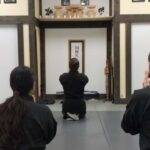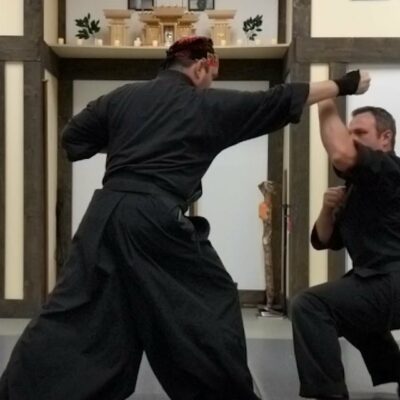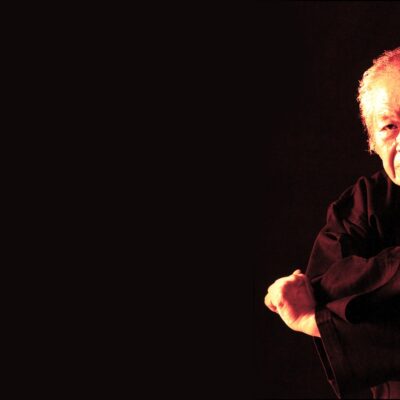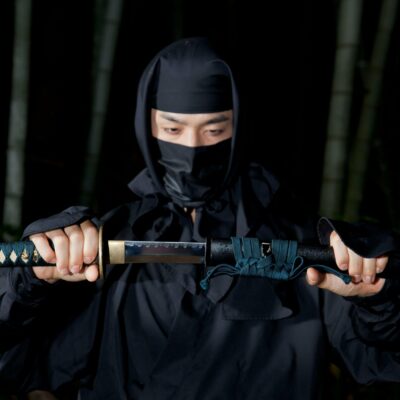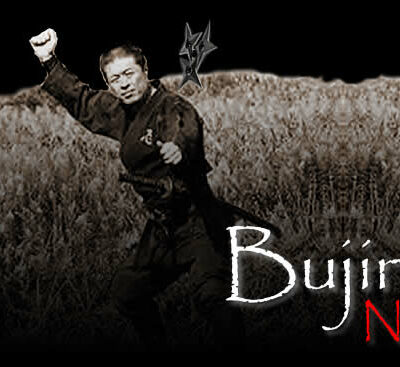Few events are as a mind blowing, mystical, and life changing in Ninjutsu training as when the time comes for a student to pass the Sakki test to achieve Godan. It’s a rite of passage that culminates after a decade of studying our art. I came to a realization about the science about such a meta-physical type of event after passing mine in September of 2012.
But what is the Sakki test, and how does it work?
The Sakki Test
“Sakki” loosely translates to “ominous intention” and is based around the concept of developing the ability to sense someone’s dangerous intention to hurt you. It involves you kneeling – eyes closed – in front of the person administering the test. The person administering the test stands behind you holding a sword over your head with their eyes closed as well.
It is up to the student to determine the moment that the persom gives the intention to hit the student and swings down on their head, signified by rolling out of the way of the sword just in time.
Preparing for the Test
I went to Japan in September last year. It was the first time I had traveled there with out my teacher nor anyone from our school.
I was promoted to Yondan by Shiraishi Sensei – in itself a high compliment. I was very proud that I was able to reflect so highly upon my teacher, Shihan Matthew Woodard. Shiraishi Sensei then said he would be happy to help me prepare for passing the Sakki/Godan test. In truth, Shihan Woodard over the years had also done quite a bit of training focusing on being able to feel this intention.
So I arrive to one of Shirashi Sensei’s classes a bit early, and he offers to show me a few things to help prepare. He corrected a few things with my ukemi to more effectively roll, my posture when waiting for the hit, and a few things to consider to better sense the moment. At the end of the lesson he said “I think you take test tonight”.
My heart stopped. I have been studying for only 7+ years, just got promoted to Yondan less than 24 hours ago, and now I face the sword (granted they use a bokken – not a real sword) in the Godan test. Overwhelming would have been an understatement. Confused and afraid to offend the teacher, I tried to politely refuse. I said I think I need to come back in a year so that I could practice what I learned. Shiraishi Sensei, smiling as always, said “no you take tonight.” I said,” I think I may need to talk to my teacher Shihan Woodard.” Still smiling Shiraishi Sensei said “he is my friend – I know him. You can ask but it’s okay.” At the end of class, Shiraishi Sensei decided to drop another bombshell on me: “Tonight in Soke class I will be your training partner, that way you’re not so nervous.” Of course, because training with the teacher (and one of Soke’s uke) is not nerve-racking at all (insert sarcasm here).
Due to the time difference, I couldn’t get a hold of Shihan Woodard. After sending several texts, Soke’s class arrives. I figure, maybe, I can slip by unnoticed and wait for next trip to take the test. As soon as I walk in, Shirashi-sensei finds me. And he comes bearing more news: “One of the Japanese Shihan may give you the test.” Okay – now I am really nervous. Typically, a Shihan from your country gives the test – and I have never seen a Japanese Shihan give a foreigner the test. More pressure please.
Test Time
The class commences, and I’m trying to keep up with Shiraishi-Sensei. He of course takes it easy on me, and having someone of his caliber helping me through Soke’s class was nothing short of amazing. I was able to gain a peak deeper into what Soke was doing, as though Shirashi-Sensei was pulling back the curtain a bit. It was very much like trips to Japan with Shihan Woodard; classes that I had the opportunity to train with him when our group went were when I gained the greatest depth of understanding. During the break, they ask if anyone is taking the Godan test tonight. I glance at Shiraishi-Sensei who gives me a firm, yet reassuring nod, and I raise my hand. The person counts and says “just two?”, then quickly walks away.
Finally the end of class comes, and I am completely exhausted. I have a thought that they may forget to administer the test. No such luck. They ask for those taking to test to line up. The other person taking the test either didn’t exist, or decided not to: it’s just me. The class lines up and I see Noguchi-Sensei holding the bokken – it’s time.
I kneel in front of him. I decide I don’t care if I get hit. I then run through the check list in my head comprised of lessons of both Shiraishi-Sensei and Shihan Woodard
Shiraishi’s Voice ” Clench teeth lightly and lead with your chin when you roll. Sit straight.”
Then Woodard’s Voice “Relax. When you feel ready, think in your head to ask to be hit. Wait until it feels like you can’t wait anymore.”
I try to stay still as I feel the bokken raise up. I keep repeating the above things in my head, and remind myself that who cares if I get hit. Then I think, “Okay – please hit me”. Silence. Then the ever so slight crinkle of hands gripping. “Wait until you can’t anymore”. Then it feels like a freight train is a foot behind me. “MOVE NOW!” I roll, come up, and here Soke shout “Hai OK!” Then applause, handshakes, and it’s over. What just happened?
The Process Explained…
I am a scientific-minded person, yet I find it difficult to explain what I felt, and why I felt it. I don’t quite believe in “Ki/Chi” but rather think it’s a means of expressing something more complex. I kept replaying things in my mind asking myself “how did it happen?”
I stumbled upon what I believe is the answer in a book that has absolutely zero to do with Martial Arts. The book is “Blink” by Malcolm Gladwell.
Essentially, Malcolm Gladwell explains, people make rapid decisions by a process he refers to as “thin slicing”. This slicing is where someone uses a thin slice of experience and information to make a subconscious decision. Interestingly enough, experts create a better slice by experience in their field. He also postulates when we try to consciously get involved in the process, we throw it off (although experts become better at being able to tap into it). In the book he gives countless examples of this and how very accurate it is.
Training gives us information to use to thin slice: when someone does A you do B. After training a long-time, things become reactionary. And eventually, our cumulative experience enables us to effectively “thin slice” a situation. It’s also why Soke constantly talks about focusing on the feeling; when you’re attacked and you have to make split second decisions, you’re not going to be thinking about steps of a technique, but are rather going to be moving based on what’s in grained, by thin slicing your training according to the moment.
Rewind to the test. The feeling that pushed me to move was my unconscious mind was telling me that danger was coming. It arrived to this conclusion based on the inputs it was receiving – the sounds in the room, the feeling of weight shifting on the mats, etc. etc. to determine the attack was happening. Where we mess up is when we either disregard this feeling, or try to over-analyze or interfere with this process. So instead of a Sixth sense, it’s really 5 senses uninterrupted. In fact, being so exhausted for the test actually helped me pass, since it kept me from over thinking things.
Beyond the Test
In truth, this process isn’t tied to just Bujinkan or Martial Arts training. We use it every day, and it’s a key component to human communication (we read facial expressions in context of someone talking to gain better understanding of what’s being communicated). Odds are, if you’re an expert in your field, you already have experienced this on some level.
So while the metaphysical explanation of sensing a person’s thought or energy isn’t quite accurate – or at least what I believe, it is an easy way to explain a very real phenomenon that comes with experience and training.
So what do you think about the Sakki test? Let us know your opinion in the comments below.


